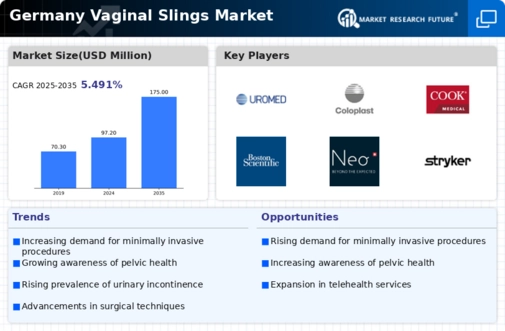Increasing Awareness of Women's Health Issues
The rising awareness surrounding women's health issues in Germany is a pivotal driver for the vaginal slings market. As more women become informed about conditions such as urinary incontinence, there is a growing demand for effective treatment options. Educational campaigns and healthcare initiatives are contributing to this awareness, leading to an increase in consultations with healthcare professionals. This trend is reflected in the market, where the demand for vaginal slings is projected to grow at a CAGR of approximately 6% over the next few years. The emphasis on women's health is likely to encourage more women to seek surgical solutions, thereby expanding the market further.
Technological Innovations in Surgical Procedures
Technological innovations in surgical procedures are transforming the vaginal slings market in Germany. Advancements in minimally invasive techniques and the development of new materials for slings are enhancing patient outcomes and reducing recovery times. For instance, the introduction of robotic-assisted surgeries has improved precision and reduced complications associated with traditional surgical methods. This evolution in surgical technology is likely to attract more patients seeking effective solutions for urinary incontinence. As a result, the market is expected to expand, with an increasing number of healthcare facilities adopting these advanced techniques to meet patient demands.
Growing Preference for Minimally Invasive Procedures
The growing preference for minimally invasive procedures is significantly influencing the vaginal slings market. Patients in Germany are increasingly opting for surgical options that promise shorter recovery times and reduced postoperative discomfort. Vaginal slings, being less invasive compared to traditional surgical methods, align well with this preference. This shift in patient attitudes is likely to drive demand for vaginal slings, as more women seek effective solutions with minimal disruption to their daily lives. The market is poised for growth as healthcare providers adapt to this trend by offering more minimally invasive options for treating urinary incontinence.
Rising Healthcare Expenditure and Insurance Coverage
The rising healthcare expenditure in Germany is a crucial driver for the vaginal slings market. With increased investment in healthcare services, more patients are gaining access to surgical treatments for urinary incontinence. Additionally, many health insurance plans are beginning to cover the costs associated with vaginal sling procedures, making them more accessible to a broader population. This trend is likely to encourage more women to consider surgical options, thereby boosting market growth. The combination of higher healthcare spending and improved insurance coverage is expected to create a favorable environment for the vaginal slings market in the coming years.
Aging Population and Increased Incidence of Pelvic Disorders
Germany's aging population is another significant driver impacting the vaginal slings market. As the demographic shifts towards an older age group, the incidence of pelvic disorders, including urinary incontinence, is expected to rise. Statistics indicate that nearly 30% of women over the age of 60 experience some form of urinary incontinence, which necessitates effective treatment options. This demographic trend is likely to fuel the demand for vaginal slings, as they offer a minimally invasive solution for managing these conditions. Consequently, the market is anticipated to witness substantial growth, driven by the need for innovative and effective treatment alternatives.




















Leave a Comment